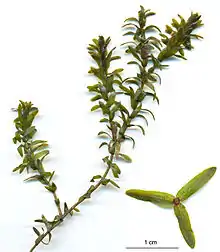Elodea canadensis
Elodea canadensis (American waterweed or Canadian waterweed or pondweed) is a perennial aquatic plant, or submergent macrophyte, native to most of North America.[1][2][3] It has been introduced widely to regions outside its native range and was first recorded from the British Isles in about 1836.[4]
| Elodea canadensis | |
|---|---|
 | |
| Scientific classification | |
| Kingdom: | Plantae |
| Clade: | Tracheophytes |
| Clade: | Angiosperms |
| Clade: | Monocots |
| Order: | Alismatales |
| Family: | Hydrocharitaceae |
| Genus: | Elodea |
| Species: | E. canadensis |
| Binomial name | |
| Elodea canadensis | |
| Synonyms | |
| |
Distribution
The native range of the species lies within North America, but it has been introduced in many parts of the world either intentionally or not. Europe has been particularly affected with the first record dating back as far as 1836.[5] Since then, the species' presence has been confirmed in all continental European countries.[6]
Records of the species' presence in Ireland include: County Galway, found at several sites along the Eglinton Canal, County Galway,[7] County Down. and from the Lagan Canal near Lisburn, Northern Ireland.[8]
Description
Young plants initially start with a seedling stem with roots growing in mud at the bottom of the water; further adventitious roots are produced at intervals along the stem, which may hang free in the water or anchor into the bottom. It grows indefinitely at the stem tips, and single specimens may reach lengths of 3 m or more.
The leaves are bright green, translucent, oblong, 6–17 mm long and 1–4 mm broad, borne in whorls of three (rarely two or four) round the stem.[9] It lives entirely underwater, the only exception being the small white or pale purple flowers which float at the surface and are attached to the plant by delicate stalks.
It is dioecious, with male and female flowers on different plants. The flowers have three small white petals; male flowers have 4.5–5 mm petals and nine stamens, female flowers have 2–3 mm petals and three fused carpels. The fruit is an ovoid capsule, about 6 mm long containing several seeds that ripen underwater. The seeds are 4–5 mm long, fusiform, glabrous (round), and narrowly cylindrical. It flowers from May to October.[1][2][3][10]
It grows rapidly in favorable conditions and can choke shallow ponds, canals, and the margins of some slow-flowing rivers. It requires summer water temperatures of 10–25 °C and moderate to bright lighting.[10]
It is closely related to Elodea nuttallii, which generally has narrower leaves under 2 mm broad. It is usually fairly easy to distinguish from its relatives, like the Brazilian Egeria densa and Hydrilla verticillata. These all have leaves in whorls around the stem; however, Elodea usually has three leaves per whorl, whereas Egeria and Hydrilla usually have four or more leaves per whorl. Egeria densa is also a larger, bushier plant with longer leaves.[11]
Cultivation and uses
It is frequently used as an aquarium plant. Propagation is by cuttings.[12]
It is an invasive species in Europe, Asia, Africa, and Oceania. It was introduced into County Down, Ireland in about 1836, and appeared in Great Britain in 1841, spreading through both countries in ponds, ditches and streams, which were often choked with its rank growth.[13][10][11][14]
Other common names for this plant include Anacharis (an older name for the genus Elodea), water thyme, common elodea, and ditch moss.
Gallery
 Ditch with a dense colony of flowering plants
Ditch with a dense colony of flowering plants Illustration showing leaf and flower detail
Illustration showing leaf and flower detail Leaf cells at 450x magnification
Leaf cells at 450x magnification
References
| Wikimedia Commons has media related to Elodea canadensis. |
- Flora of North America: Elodea canadensis
- Plants of British Columbia: Elodea canadensis
- Jepson Flora: Elodea canadensis
- Hackney, P. 1992.(Ed.) Stewart and Corry's Flora of the North-east of Ireland. Institute of Irish Studies and The Queen's University of Belfast. ISBN 0-85389-446-9 (HB)
- Simpson, D.A. (1984). "A short history on the introduction and spread of Elodea Michx. in the British Isles". Watsonia. 15: 1–9.
- Poulis, Georgios; Zervas, Dimitrios (2017-12-20). "First confirmed record of Elodea canadensis Michx. (Hydrocharitaceae) in Greece". Hacquetia. 16 (2): 175–179. doi:10.1515/hacq-2017-0001. ISSN 1854-9829.
- Pybus, C. and O'Halloran, P. 2009. Distribution of some submerged aquatic macrophytes in the Eglinton Canal, Galway; Ir. Nat J. 30: 51 -53
- Hackney, P. 1992
- Rose, Francis (2006). The Wild Flower Key. Frederick Warne & Co. pp. 485–486. ISBN 978-0-7232-5175-0.
- Huxley, A., ed. (1992). New RHS Dictionary of Gardening. Macmillan ISBN 0-333-47494-5.
- Native Freshwater Plants: American Waterweed Archived 2005-06-13 at the Wayback Machine
- Hiscock, P. (2003). Encyclopedia of Aquarium Plants Interpret Publishing, United States and Canada ISBN 0-7641-5521-0.
-
 One or more of the preceding sentences incorporates text from a publication now in the public domain: Chisholm, Hugh, ed. (1911). "Water-thyme". Encyclopædia Britannica. 1 (11th ed.). Cambridge University Press. p. 410.
One or more of the preceding sentences incorporates text from a publication now in the public domain: Chisholm, Hugh, ed. (1911). "Water-thyme". Encyclopædia Britannica. 1 (11th ed.). Cambridge University Press. p. 410. - Flora of NW Europe: Elodea canadensis Archived 2008-03-11 at the Wayback Machine